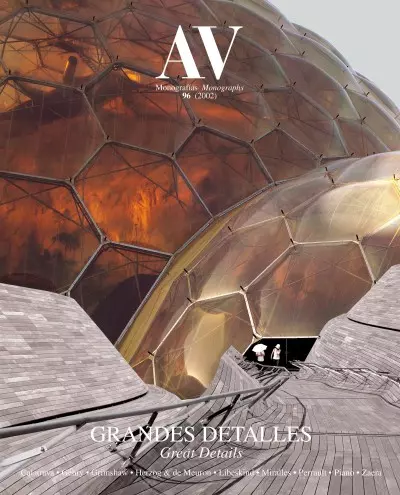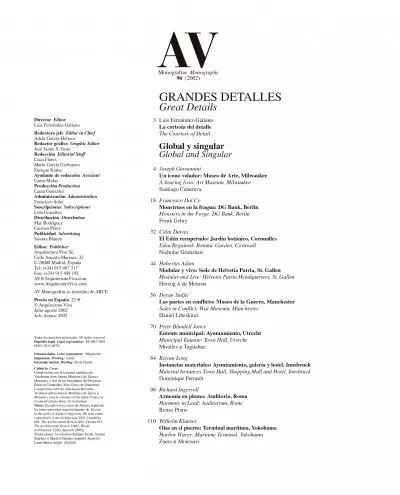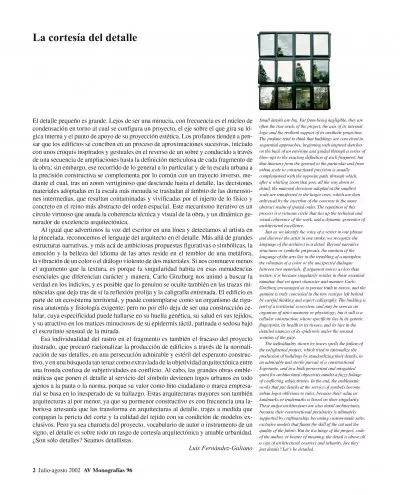GRANDES DETALLES
Great DetailsLuis Fernández-Galiano
La cortesía del detalle
The Courtesy of Detail
Artes y oficios
Arts and Crafts
Joseph Giovannini
Un icono volador: Museo de Arte, Milwaukee
A Soaring Icon: Art Museum, Milwaukee
Santiago Calatrava
Francesco Dal Co
Monstruos en la fragua: DG Bank, Berlín
Monsters in the Forge: DG Bank, Berlin
Frank Gehry
Colin Davies
El Edén recuperado: Jardín botánico, Cornualles
Eden Regained: Botanic Garden, Cornwall
Nicholas Grimshaw
Hubertus Adam
Modular y vivo: Sede de Helvetia Patria, St. Gallen
Modular and Live: Helvetia Patria Headquarters, St. Gallen
Herzog & de Meuron
Deyan Sudjic
Las partes en conflicto: Museo de la Guerra, Manchester
Sides in Conflict: War Museum, Manchester
Daniel Libeskind
Peter Blundell Jones
Entente municipal: Ayuntamiento, Utrecht
Municipal Entente: Town Hall, Utrecht
Miralles & Tagliabue
Kieran Long
Instancias materiales: Ayuntamiento, galería y hotel, Innsbruck
Material Instances:Town Hall, Shopping Mall and Hotel, Innsbruck
Dominique Perrault
Richard Ingersoll
Armonía en plomo: Auditorio, Roma
Harmony in Lead: Auditorium, Rome
Renzo Piano
Wilhelm Klauser
Olas en el puerto: Terminal marítima, Yokohama
Harbor Waves: Maritime Terminal, Yokohama
Zaera & Moussavi
Luis Fernández-Galiano
The Courtesy of Detail
Small details are big. Far from being negligible, they are often the true seeds of the project, the axis of its internal logic and the resilient support of its aesthetic projection. The profane tend to think that buildings are conceived in sequential approaches, beginning with inspired sketches on the back of an envelope and guided through a series of blow-ups to the exacting definition of each fragment; but that itinerary from the general to the particular and from urban scale to constructional precision is usually complemented with the opposite path, through which, after a whirling zoom that goes all the way down to detail, the material decisions adopted at the smallest scale are transferred to the larger ones, which are then enlivened by the insertion of the concrete in the more abstract realm of spatial order. The repetition of this process is a virtuous circle that ties up the technical and visual coherence of the work, and a dynamic generator of architectural excellence.
Just as we identify the voice of a writer in one phrase and discover the artist in one stroke, we recognize the language of the architect in a detail. Beyond narrative structures or symbolic proposals, the emotion of the language of the arts lies in the trembling of a metaphor, the vibration of a color or the unexpected dialogue between two materials. If argument moves us less than texture, it is because singularity resides in those essential minutiae that set apart character and manner. Carlo Ginzburg encouraged us to pursue truth in traces, and the genuine is truly concealed in the tiny vestiges left behind by careful thinking and expert calligraphy. The building is part of a territorial ecosystem, and may be seen as an organism of strict anatomy or physiology; but it still is a cellular construction, whose specificity lies in its genetic fingerprint, its health in its tissues, and its lure in the detailed nuances of its epidermis under the sensual scrutiny of the gaze.
The individuality shown by traces spells the failure of the enlightened project, which tried to rationalize the production of buildings by standardizing their details, in an admirable and sterile pursuit of a constructional Esperanto, and in a both perseverant and misguided quest for architectural objectivity amidst a fuzzy foliage of conflicting subjectivities. In the end, the emblematic works that put details at the service of symbols become urban logos oblivious to rules, because their value as landmarks or trademarks is based on their singularity. These major architectures are also detail architectures, because their constructional peculiarity is ultimately supported by craftmanship, becoming custom-made suits, exclusive models that flaunt the skill of the cut and the quality of the fabric. But be it a hinge of the project, code of the author, or bearer of meaning, the detail is above all a sign of architectural courtesy and urbanity. Are they just details? Let’s be detailed.








